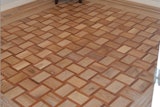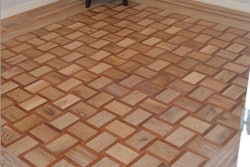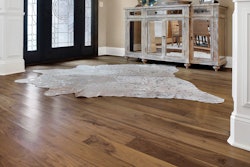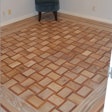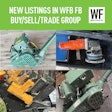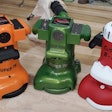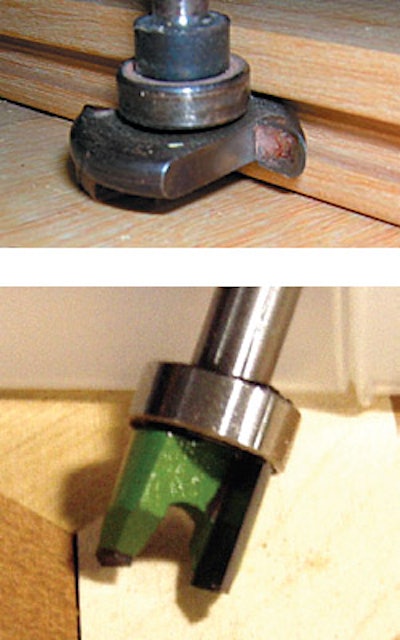
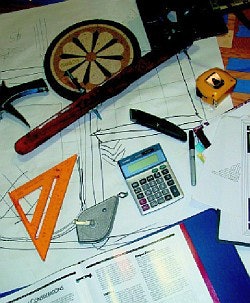
Hundreds of years ago, artisans used only their hand tools to create amazingly intricate wood floors in castles and palaces. Today, wood flooring craftsmen continue to create masterpieces, but they have the benefit of endless advancements, not the least of which is electricity. A modern high-end wood flooring contractor drools over power tools like Pavlov's dog, and his toolbox overflows with little gadgets that make his job easier, or at least more fun.
While the number of fancy tools and gadgets in an elite contractor's toolbox may seem intimidating, they aren't all essential. However, if you're looking to upgrade your installation business from plain strip flooring to custom floors involving borders, inlays and custom parquet, you should invest in some key equipment that offers you the precision you'll need.
Without it, your foray into custom work may lead to lots of frustration and wasted time.
Power Up
Most contractors already own a circular saw and a chop saw, and maybe a table saw, but when they get involved in precise custom work, they usually need to upgrade these key tools.
Circular saw: A good-quality circular saw is crucial for cutting fields for feature strips or borders; many lower-end saws won't hold up and have too much play in the bearings to cut as precisely as is necessary for this work. A heavy-duty saw with an 8-inch base plate, a 7 1/2 -inch blade and at least 1 3/4 hp is desirable. Be cautious about using a circular saw with a worm drive, which will tend to kick to the left at startup.
To use the circular saw to cut the field for a border, a straightedge is necessary. Contractors can make their own straightedge for their particular saw (see sidebar on page 52), or they can purchase a prefabricated plunge saw/straightedge combination.
 Custom floors require specialized router bits, such as (top) the grooving bit and (bottom) a bit for dropping in inlays.
Custom floors require specialized router bits, such as (top) the grooving bit and (bottom) a bit for dropping in inlays.
Chop saw: A custom wood flooring contractor will give this tool a continuous workout, so again, a higher-end, heavy-duty saw is recommended. A sliding compound miter saw offers the most capabilities in cutting all different types of angles and board widths; look for one with a double beam, which offers more stability than a single-beam model.Also look for a saw with the capacity to cut past 45 degrees, and check the ease of adjustability when adjusting the angles. Many contractors find that saws with laser beam guides are helpful. Also check the saw guard device to make sure it isn't too cumbersome, tempting workers to remove it entirely, which is both dangerous and illegal.
Table saw: When working with custom floors, it becomes necessary to rip boards with exact precision, so a quality table saw becomes an important tool. As your skills increase, you'll likely find the table saw even more useful, as you rip boards to "bend" wood and create jigs for the saw that help you manufacture custom parquet, French knots or other features.
Small portable table saws usually aren't enough to handle these tasks; however, larger table saws can easily weigh several hundred pounds, making them cumbersome to take to a job site. Most likely, you'll need to find a happy medium between the two. The saw should have a stable fence that can be set up to work on either side of the blade, and a cutting depth of at least 2 inches.
Router: A good router is essential for just about any custom wood flooring work. It's necessary for dropping in inlays and regrooving the sides and ends of boards. Since the router takes a heavy workload, it needs to be strong; most high-end contractors recommend a minimum of 1 1/4 hp or more. When cutting large radii or other demanding work, contractors often use a 2- or 3-hp router.
 Swing arms attached to a stationary base plate router can be used to cut radii large or small.
Swing arms attached to a stationary base plate router can be used to cut radii large or small.
Different types of routers are designed for different functions. Most contractors find they need at least two routers: one stationary-base-plate router for regrooving board edges, cutting endmatches and cutting radii, and a plunge router for cutting with templates to drop in inlays. Stationary-base-plate routers can be used for cutting with a template, but a plunge router is much easier and safer.
When shopping for a plunge router, look for one that has easily adjustable depth settings, since you'll often be making multiple passes at different depths in immediate succession. For a stationarybase-plate router, check the base to see how easy it will be to attach a swing arm for cutting radii (more on that below). For any type of router, check the ergonomics—it should be comfortable to hold and easy to turn on and off.
Some special bits are required for the router's wood flooring jobs. To regroove boards to accept spline, you'll need a grooving bit manufactured specifically for wood flooring. It has a top guide bearing above the cutting bit that allows you to cut the groove without using a straightedge (always doublecheck that the bit is set at the correct depth before actually cutting the floor).
For inlays, you'll need a bit with a top guide bearing that allows you to cut out the area for the inlay while running against the edge of the template. Some inlay manufacturers provide this bit with the inlay and template; others do not. For a clean cut, you'll need to cut out the floor with multiple passes, each time lowering the bit by no more than 1/4 inch (some harder species may require even smaller adjustments).
When dropping metal strips or wood accent pieces into a wood floor, usually to a depth of 1/4 inch, you'll need a spiral bit. This bit does not have a top guide bearing, so the router needs to be used in conjunction with a straightedge or a swing arm. The swing arm also is essential when doing radius work. It's simply an arm that is fixed at the center point of the circle on one end and attached to the router's base plate at the other, allowing the router to cut perfect circular arcs. These are available from several manufacturers, or some contractors make their own out of plywood or Lucite.
Little Things That Count
Fortunately, once you have the above, you're probably set for essential largeticket items. But the big tools aren't the only important ones. Following are some smaller items that may help make your job easier or more accurate. Some are hard to do without; others are just nice to have.
 Trammel points are essential for custom layouts.
Trammel points are essential for custom layouts.
Trammel points: Perhaps you already use trammel points to help you square up your layouts, or maybe you simply rely on the standard 3-4-5 triangle. Once you're working with custom layouts, however, trammel points are infinitely useful. They attach to any straightedge and use basic geometry to help you do anything from finding a center line to bisecting angles. When you're ready to snap lines, you'll need a …
Chalk box with a fine line: Every wood flooring contractor has (or should have!) a chalk line. A standard line can leave a relatively thick mark, which is fine when you simply need to start from a center line to install a strip floor. However, when you need precision for detailed custom work, you'll probably find that the standard line is too thick, allowing too much leeway in the measurement. So, replace the line with a thinner one, or you can use braided fish line for a precise mark. Remember, fine lines make fine cuts. As you're making those cuts, you need to watch out for fasteners in the floor, which is why you need a …
 Stud finders are useful to avoid hitting fasteners with your router and circular saw, and some contractors even have been known to customize them.
Stud finders are useful to avoid hitting fasteners with your router and circular saw, and some contractors even have been known to customize them.
Stud finder: This simple little gadget can be a huge help when you're working with the circular saw or router, saving wear on your bits or blades. You just run it over the area where you'll be cutting, and it indicates where the nails are. Any time you'll be cutting the field, use the stud finder to mark spots with fasteners, which are usually about 1/4 inch below the surface in standard 3/4 -inch flooring. Once the nail head is barely exposed, you can use a nail set to force the fastener down below the path of the saw or router. Of course, whenever possible, plan ahead by trying not to nail where you know you'll be cutting the field for a border or inlay. Once you've set nails and completed your cuts, you may need a …
Good chisel set: Again, most contractors have chisels, but when doing finer work, they usually need to upgrade the quality of the chisels, and they need high-quality sharpening equipment, also. A sharp chisel is imperative for tasks such as cleaning up sharp angles in a template where the router can't reach. Of course, if that angle is a square corner, you can use a …
 One swing of the hammer on the corner chisel punches a clean right angle.
One swing of the hammer on the corner chisel punches a clean right angle.
Corner chisel: This convenient little spring-loaded contraption is often used by the cabinetry trade to punch a clean right angle, and it comes in handy for the same purpose on floors. One hard hit from the hammer cuts a precise 90-degree corner with no need for a hand chisel. Another contraption from the cabinetry trade that some specialty wood flooring contractors find useful is a …
Biscuit cutter: This tool offers a method to lock adjoining flooring together that is more precise than routing a new tongue and using spline. Thin "biscuits" are inserted into the narrow grooves created by the biscuit cutter. Speaking of keeping floors together, you'll need lots of …
Clamps: Most contractors have some clamps, but the more specialty work you do, the more you'll find yourself needing these handy items. They serve numerous purposes, from holding together parts of a custom border or "bent" radius while it dries to holding down a jig or stop block on a table saw or chop saw. If you're inlaying metal along with those custom elements, you may want a ...
 Gear-driven ring rollers easily bend metal to the circular shape you need.
Gear-driven ring rollers easily bend metal to the circular shape you need.
Gear-driven ring roller: This contraption allows you to easily bend metal strips into circular shapes. Getting in Deep Once you've got some essentials taken care of, there are endless tools and gadgets that can fill your toolbox. As you get more involved with custom floors, you may find these items handy, although not always necessary.
Getting in Deep
Once you've got some essentials taken care of, there are endless tools and gadgets that can fill your toolbox. As you get more involved with custom floors, you may find these items handy, although not always necessary.
Miter box: Miter boxes have been used with fine hand-saws for years to make cutting different angles easier. Today, you can use miter boxes clamped onto your chop saw for jobs such as manufacturing parquet. A box that will perform multiple functions, such as a compound slide miter box that allows you to cut wide plank flooring or stair treads, is the most useful.
Jig saw: Some contractors find jig saws indispensable for making rough cuts, since they can be easier and faster than cutting with the circular saw and offer the flexibility for cutting curves. Look for a higher-quality jig saw that has adjustability for the verticality of the cut. Some also have adjustability for the side-to-side motion of the blade, allowing contractors to increase the kerf and prevent binding of the blade.
Band saw: Band saws are useful for cutting very small pieces of wood flooring, as they can cut very fine lines. A band saw is essential for cutting products such as fingerblock parquet safely, without the wood pieces shooting dangerously off the saw.
Planer: Any time a wood component is ripped and molded back together, such as when building a "bent" radius, a planer can be a useful tool for evening it back out. Even a 12-inch, portable planer can be useful.
Once you've invested in your tools, make sure you maintain them. Bearings need to be extracted and lubricated, brushes wear, and saw triggers can burn out. Find a local shop where you know you can get replacement parts and where, hopefully, you can learn how to do some basic maintenance yourself.
While some wood flooring contractors may never even dream of owning all these tools, for others, the ones mentioned in this article are a mere beginning. Remember that the most important tool of all is knowledge. Money spent traveling to a wood flooring school (see "The Most Important Tool" sidebar below) or working with a colleague experienced in custom floors is worth more than the fanciest gadget you don't know how to use.
Circular Saw Straightedge
Making a straightedge for your circular saw is relatively easy. Since each saw is slightly different, each straightedge needs to be custom made for a particular model and brand of saw. For the straightedge, MDF or CDX plywood works well. Rip 1 to 2 inches off the full length of a sheet, then attach the strip lengthwise down the edge of the sheet using glue, screws or nails. To make sure it's straight, chalk a fine line on the sheet before attaching the rip. Next, doublecheck that your circular saw is cutting a perfect 90 degrees—it's best to check with the blade set as deep as the saw will cut. Now, set the saw blade just deep enough to cut through the thickness of the plywood, and butt the edge of the base plate farthest from the blade against the rip you attached. Keeping the saw firmly against the rip, saw the full length of the plywood. The result is a straightedge custom fit to that saw. When cutting more than 8 feet, you can make as many as you need and butt them end to end. |












